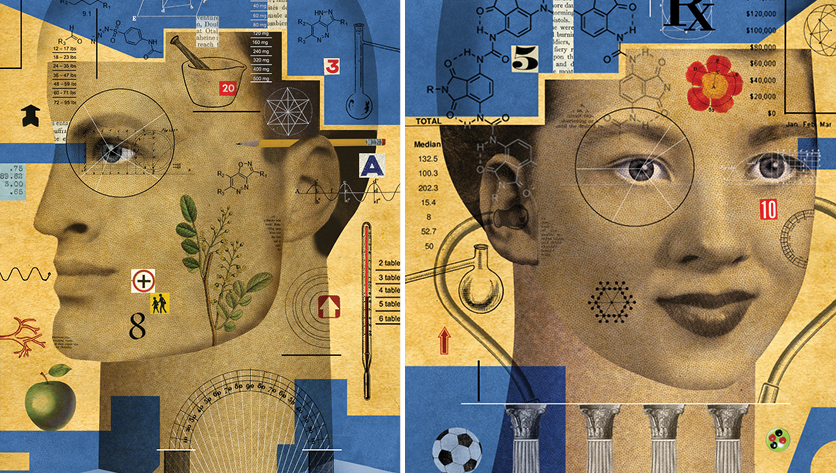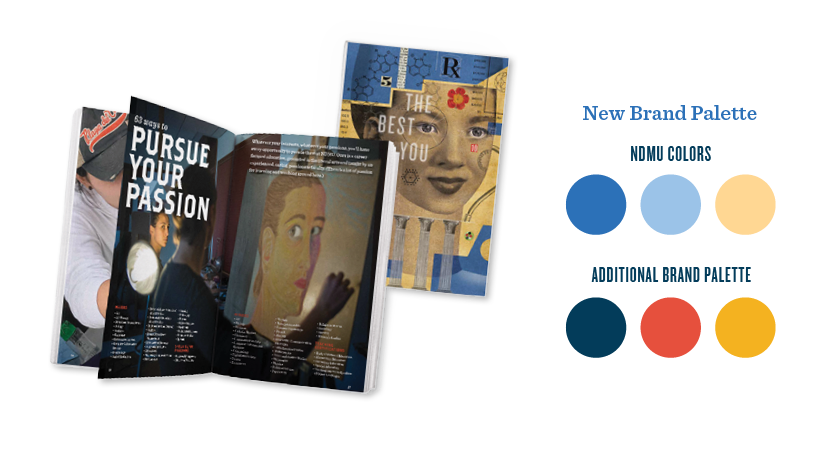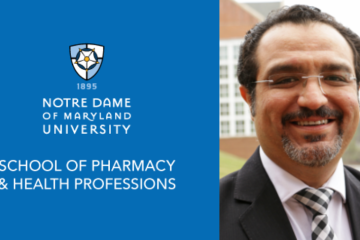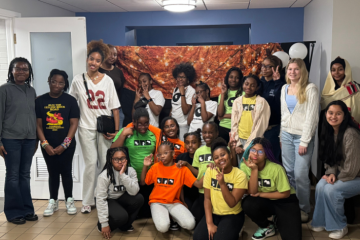Introducing NDMU’s New Inspirational Brand

Notre Dame of Maryland University has launched new branding for the University with inspiring words for students and potential students: “The World Needs the Best You.”
The University began its official launch of “The Best You” this summer, first introducing the campus to new banners along North Charles Street and a refreshed website. Notre Dame has begun implementing “The Best You” as it recruits new students for all programs—Women’s College, College of Adult Undergraduate Students, Graduate Studies and The School of Pharmacy.
Like all good branding, this platform rests on a significant foundation to ensure authenticity. The branding initiative was part of the 2015-2020 Strategic Plan “Inspired by Tradition: The Path to Transformation,” specifically in support of institutional effectiveness and enrollment growth goals.
President Marylou Yam explains: “As an institution, we have to know ourselves. The research helps us to know who we are and how we are perceived.”
At Notre Dame, branding is rooted in mission. Yam describes the outreach process that is integral to gaining input from students and potential students: “Here’s our mission, here’s what we believe in, but we want to hear what you need, what’s helpful to you.”
Alumnae/i were also an important part of the process. Yam says she is thankful for all of the alums who participated in the research and offered their time and perspective. Feedback from alums about how Notre Dame helped to shape their lives, both personally and professionally, is key in developing strong and accurate branding.
Although many people will be most aware of the new visuals and marketing materials, the branding initiative was a multi-year effort that now informs decision-making across the University.
Listening to Students, Alumnae/i, Parents, Faculty and Staff
The first step of the branding initiative was gathering information from key constituents about their perceptions of Notre Dame of Maryland University.
The University hired SimpsonScarborough, a leading higher education marketing, branding and research firm located in Alexandria, Virginia. SimpsonScarborough zeroed in on overall awareness of the University, comparison to peer schools, key brand associations, distinctiveness, appealing messaging and negative perceptions. They also measured levels of alumnae/i pride and loyalty.
Dr. Yam stressed the need for significant input from a range of constituents. She says “It was important to us…to give voice to those who have love for the university so that they all would be represented. Those audiences that know us really well [include] students, alums, faculty and staff, community members.” It was also important to reach out to prospective students and, in the case of traditional undergraduates, their parents.
A branding initiative task force of staff and faculty members worked with SimpsonScarborough throughout the process, identifying constituent groups, fine tuning questionnaires, answering questions and helping to facilitate the firm’s work. Maricka Oglesby, director of Notre Dame’s Women’s Leadership Institute of Baltimore, served on that group. She says, “this initiative brought together time, effort, thought leadership--real consideration for who we are as an institution and how we want to portray ourselves.”
The firm brought not only its expertise but also its objectivity to ensure a valuable process. The consultants started by reviewing existing branding, marketing and communication efforts. Then, there were two rounds of online surveys: the first to gather data and the second to test messaging and creative approaches to convey the brand.
The resulting data was shared with the task force, the Board of Trustees and faculty/staff. Yam remarks “The research confirmed for us that our stakeholders, all of them, are interested in the empowerment of our students to be successful.” All internal constituents rated the University highly for empowering students to play a key role in the world today.
Current students value diversity, faculty relationships, women’s issues, and openness to all faiths. According to Yam, “It is refreshingly positive when you get affirmation…. that what constituents really want is something that the University is delivering on, is applying, is doing well.” Other identified strengths of Notre Dame include student support and hands-on learning.
Prospective students are looking for colleges with strong outcomes, hands-on learning, rigorous academics, high quality faculty and diversity, the research found. Potential students for graduate programs and adult programs are most interested in flexibility and strong faculty. Prospective students in all programs indicate that they want a school that challenges them to be their best selves.
Survey respondents indicated the top NDMU academic programs as education, nursing (including RN to BSN) and pharmacy. External audiences were not as aware of specific programs at the University.
Traditional undergraduate students understood the University to be for women, while adult students think of NDMU as a university for both female and male students. Traditional undergraduate students, current and potential, also reported that they are drawn to a community that has a passion for helping others in need. Adult students are attracted to a community that expects respect for self and others. Respect for and celebration of diverse opinions was either ranked highly or as the top consideration across all student audiences.
Building a Brand Platform
Dr. Heather Carpenter, associate professor and director of the nonprofit management program at Notre Dame, describes the branding process as determining “distinguishing characteristics that set an organization apart from its competitors.”
The Notre Dame research results helped to identify and clearly articulate which attributes make up the brand, can be communicated proudly and consistently, and will help attract students who will be successful at the University.
SimpsonScarborough presented a “brand platform” featuring several different ways to conceptualize NDMU branding. The “brand essence” of the University is described as: Raising the world to a higher standard by empowering individuals to make exceptional impacts.
“It was amazing when the final platform was refined and completed because the words, the imagery, the feeling and the spirit was right on point with what the Notre Dame people know and love,” says Christian Kendzierski, associate vice president of communications and advancement marketing, who was charged with leading the primary phases of the branding initiative.
The three pillars, strengths of NDMU that support this brand essence, include “passionately impacting others; accepting and supporting all; and transforming individuals.”
Marketers articulate a brand personality to describe organizations as if they had human characteristics that everyone can relate to. The research clarified the University’s personality as accepting, compassionate, confident, determined and diverse.
Finally, the brand platform outlines a “foundation”—facts about the University which are critical to the mission. These are characteristics which may not translate to critical marketing messages, but are important parts of the overall package:
- Comprehensive liberal arts university with a strong sciences core and nationally recognized programs for women and men
- School Sisters of Notre Dame affiliation
- Best of both world’s location – Baltimore (opportunities for big-city internships, culture and socialization/recreation at the same time on a green acre campus in a suburban setting)
- Strong return on investment (ROI)
- Successful alumni
The final stage of research tested messaging and visuals to help to convey that brand platform.
Based on that feedback, SimpsonScarborough presented a message that directly addresses students and potential students: The World Needs the Best You.
Dr. Yam was pleased, saying, “The idea of being your best self-resonated so well with our mission.”
The approved brand platform was the launch pad for new visuals and messaging to represent the Notre Dame brand to the community.
Creating a Campaign to Capture Attention and Imagination
When Scott Briell came on board as vice president for enrollment management and marketing in September 2019, he knew that translating the new brand platform into recruitment efforts would be a key undertaking in his first year. Despite the challenges of COVID-19 that resulted in few students, faculty and staff on campus, NDMU launched “The Best You” branding, (a shortened version of “The World Needs the Best You”) in late August.
The Best You
Briell was pleased with the clarity offered by the research and branding platform, and he brought in Robert Rytter, the principal at Jensen Design, to work with his team to develop new marketing materials. Not only had Rytter worked with Notre Dame on a logo project in 2000, but his wife is a proud alumna. Rytter has worked with institutions across the country, but as a local resident, he was particularly familiar with the competitive environment in the Baltimore area.
Briell feels it’s important to let students and others tell the story of the University, so marketing efforts are largely driven by testimonials in video, print and on the website.
In addition, “we wanted to do something to turn heads,” Briell says. He wanted to make sure that visuals did not conform to the standard look of so many universities. The concept: use illustrations as part of the narrative.
The illustrations are featured on the covers of the principal marketing pieces for potential students, but perhaps get the most exposure on light pole banners on Charles Street and throughout campus.
There are two versions of the artwork—one featuring a young woman’s face (on the cover of this magazine) and the other a young man, both in a complex environment. Rytter explains that the illustrations reflect the liberal arts foundation of the University. The abstract ideas pictured invite analysis appropriate to an academic institution. Banners also feature “The Best You” tagline and smaller icons of student life ranging from a soccer ball to a stethoscope.
Nationally acclaimed artist David Plunkert of Spur Design in Baltimore created the illustrations in his distinctive style. His work has appeared on the covers of The Atlantic and New Yorker magazines.
The artwork features four pillars representing IMPRINT, the distinctive Women’s College experience based on the University’s research study on Women’s Education in the 21st Century. IMPRINT focuses on personal leadership; mentorship and sponsorship; global awareness-diversity and inclusion; and teamwork and communication.

The viewbook for the Women’s College, a central publication for undergraduate student recruitment, features the artwork with the woman’s face and represents the small and powerful nature of the University—it’s 80 pages long and about the size of a paperback book.
Adult and Graduate Studies materials feature the male student face on the cover. Messaging begins with “You know what you want” to appeal to these students’ needs for flexibility and professional advancement.
The University introduced and expanded its official colors of blue, white and yellow to include navy blue, red and gold. The addition of the vibrant colors helps the University to stand out especially at admissions events and college fairs.
The website has been updated to reflect the new branding. Mallory Cerda, director of marketing, notes that there are two phases of the refresh. Phase I replaced the video images with a single image of a student face, which changes each time the page is refreshed. The headline: “The World Needs the Best You.” The home page content has been overhauled, and there is new copy in every major section to reflect the branding.
Cerda described the website as “the major vehicle for the University to tell its story.” Visitors to the site are most often looking for academic information, so there is a new search bar with links to each program.
Phase II will feature additional navigation improvements to “help improve the user experience for everyone,” she says.
The final marketing tool unveiled in late August is significant video footage to be edited and shared for targeted purposes. Students, President Yam and other administrators and staff members tell the story of Notre Dame.
Branded School Videos
Recent alumnae/i were interviewed in their homes or workplaces, demonstrating “life after Notre Dame.” Briell says it’s important to show “outcomes;” students want to see that graduates are not only making a living, but also making an impact on the world.
When classes switched to remote learning in early March, the ability to video classroom interaction and indoor facilities was lost. Instead, filming was done primarily outside with socially distanced, individual interviews. According to Briell, more footage will continue to be added to the arsenal.
There is a slight change to the University logo which was adopted as College of Notre Dame of Maryland became Notre Dame of Maryland University in 2011. To emphasize the history and longevity of the institution, “1895,” the year of its founding, has been added.
Branding the University
Dr. Yam emphasizes that one of the strengths of the branding is that it is comprehensive, working across the whole University.
The research results and platform continue to inform decision-making. The data and brand platform are touchstones to help evaluate undertakings throughout the University, something, Yam says, “we can refer to, to ask ourselves: is this the work that we are doing? Is this matching up with our brand platform, matching up with our mission?”
Effectively branding an institution requires ongoing effort; the University will likely revisit the branding initiative in another three to five years.
Yam notes “It’s a great process. It gives a comprehensive picture that then can inform us. It’s sort of that ‘reality check.’ It’s also a journey of discovery.”




